Cold email is like door-to-door sales. You’re going to get a lot of no’s.
Unless, that is, you learn how to write cold emails that actually convert.
Cold emails only have an average open rate of just 14-23% to begin with. Not only are you up against an unprecedented amount of inbox filtering and competition, you’ve got to bring your A-game if you want to actually drive results with cold email.
Statistic after statistic tells us that email marketing boasts one of the highest ROIs of all marketing techniques (as high as 122% in some cases). But if you want to achieve top cold email performance, you need an approach that’s a little different from what other reps are using.
Keep reading to get 25 cold email tips — in 4 areas of mastery — that you can start using today:
- Cold email tips: the basics
- Cold email tips for writing a better email
- A template for cold emails
- Cold email tips for raising open rates
- Cold email tips for boosting response rates
Let’s dive in, shall we?
THE BASICS

Email best practice applies to every email you send, regardless of its temperature. Cold emails (first touches sent to people who don’t know you) and warm emails (messages sent to people who already have some relationship with you or your product) all rely on the basics.
But before you dive into the more advanced tips in the rest of this article, make sure you lay in the groundwork first.
- Research the recipient’s company to be sure you understand how your solution would support their unique business.
- Look up each recipient’s digital footprint so that you can mention content they’ve created or shared in your message.
A ounce of prevention here isn’t worth just a pound of cure. It’s worth closed-won opportunities and lucrative new business.
Now, onto the tips!
1. Be Friendly
When you sit down to write an email, relax. You don’t need to use fancy words or perfect grammar. And you don’t need to write like a professor to sound smarter or more professional.
Great writing is about being clear and concise. And the best emails are conversational.
Your goal, then, is simply to be yourself: Write as you talk. Be friendly. Try to build rapport.
RELATED: My Friends Write Better Cold Emails Than My Vendors Do
2. Don’t Sound Like a Template
Templates are a time-saver. I get it. But if you and everyone else on the planet use the same exact templates, no one stands out. Worse still, your prospect probably has 100 other cold emails in their inbox that sound exactly like yours.
If you use templates, use them as a guide. Tweak them to sound more like you, and you’ll get far better results.
With only minor tweaking, your email will come off as more genuine, which makes the prospect more likely to respond.
So here’s what I want you to do:
- Tweak the language of your template to sound as if you wrote it.
- Or better, use your template as a model, and write a new email from scratch.
- And any time you get a really good cold email, save it to a swipe file and use it as a template for your own cold emails
COLD EMAIL EXAMPLES: The 6 Best Cold Emails Ever Sent – And Why They Worked
3. Customize and Personalize
Speaking of responses, you can double your reply rate by personalizing your emails.
Woodpecker did this with their own cold email campaigns. What they found was that advanced personalization earned a 17% reply rate, more than double the 7% reply rate for emails with no personalization.
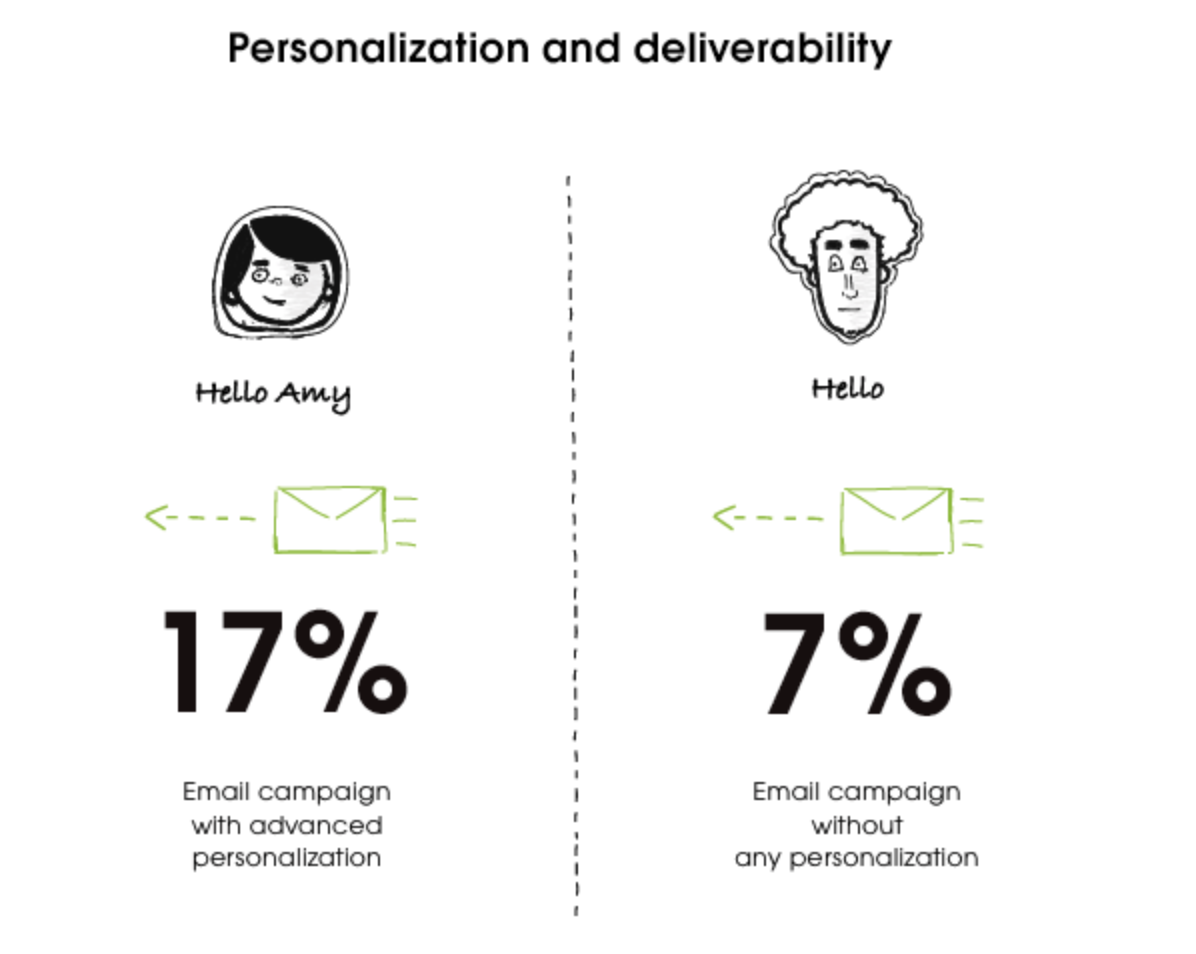
The key here is advanced personalization. You need to include elements that show you’ve written the email specifically for your recipient, rather than sending them a generic message from a big blast.
So how do you do that?
Ideally, your template contains variables that are customized for each recipient. Things like the name of their company, their geo-location, their industry. By customizing these elements, the prospect feels you’re sending a one-to-one email.
That positions you as human (as opposed to a bot). And humans are far more likely to earn a human reply.
4. Have a Clear Purpose for Your Email
It wastes everyone’s time to send a “just checking in” email. But wasting time is the least of your worries: If you regularly send emails with no purpose, you train your recipients not to open them. That’s a mistake!
Here are a few clear purposes for sending a cold email:
- Following up on an action the prospect has taken
- Offering a preview of a new report or guide
- Sharing a blog post
- Offering survey findings that could make a difference in their business
- Providing a free audit (with a written report of your findings)
- Giving away free tickets to an event
- Offering a live demo
You need to clearly state your purpose early in your email, and you need to focus on that one purpose throughout the email.
Like this cold email:

Now, to be honest, this isn’t the best example of a cold email (I’ll explain why in a moment), but it isn’t bad. And one thing it does very well is to quickly establish why I’m getting it.
I understand right away that this isn’t a random email blast. It was sent in response to an action I took on their website.
5. Make Sure Your Purpose Aligns With a (Real) Pain Point
People rarely take action until they have to. Only when not taking action is the worst possible option do they finally feel motivated to do anything about it. Otherwise, the status quo is fine.
That being the case, your email needs to address a recognized pain point. Your offer (the purpose for reaching out) simply needs to:
- Provide information about it
- Explain a solution
- Or provide tips for overcoming it
As long as the pain point exists, people will happily reply to an offer to help.
6. Give Before You Ask
You need to build trust and brand recognition before asking for something. And a simple way to do that is to offer value in advance.
That’s why cold emails tend to offer information, an audit, or a consultation first. When you give generously with no strings attached, people feel they can trust you. It also sets up a powerful persuasion principle known as reciprocity.
Robert Cialdini introduces reciprocity in his book Influence: The Psychology of Persuasion, describing it as our natural tendency to feel like we must repay even the simplest of gifts and favors.
This tendency is so strong, cultural anthropologists Lionel Tiger and Robin Fox call it a “web of indebtedness.” According to them, this need to repay is unique to human beings, and it’s actually designed to create a cluster of interdependencies that bind us together.
In other words, we’re wired to reciprocate.
So it only makes sense to give before you ask for anything. That way, when you do ask for something, you’re more likely to get a yes.
7. Sell Your Give
In a cold email, you want to keep your message focused on your “give.” You may be tempted to mention your product or start pushing the sale, but you need to resist.
If you forecast the sale, you could lose your prospect altogether.
Here’s why: People like to buy, but they hate to be sold. Especially if they don’t already know, like, and trust you.
So don’t try to jump ahead in the sales process. Sell your “give.” Nothing more.
8. Don’t Mention Your Product
Be aware, a good cold email probably won’t mention your product at all. But if you do mention it, don’t “sell” it. The only sell in a cold email should be the benefits or the outcome of your initial offer.
The Conga email I shared above violates this rule, and as a result, got no reply from me. Yes, I performed the trigger behavior, but not because I was ready to buy.
Be aware, that may also be the case with your prospect. Use your cold email to gauge interest and build trust, not to sell.
WRITING A COLD EMAIL

Okay, we’ve covered the basics. Now it’s time to look at tips for writing a cold email. Here’s what you need to know to craft a winning email that gets replies.
9. Start by Introducing Yourself
When you’re at an event and see someone you’d like to chat with, you don’t rush up and start making offers. That would be off-putting.
No, you start with an introduction. Treat cold emails like a real-life first encounter. Start with an introduction. Something like…
Hi <fname>,
[Your name] here, the [title] with [your company].
This tells the prospect right away that you’re human and don’t have anything to hide. That builds trust, which makes them more willing to read more.
10. Quickly Explain Why
Next, explain why you’re emailing — and more importantly, why they should listen.
Here’s where you’ll share your purpose, how it relates to a pain point they’re experiencing, and why it matters.
For example:
I noticed you downloaded [your company]’s ebook, [title of the ebook]. I was wondering if you’ve had a chance to look at it yet, and if so, whether you have any questions.
We recently published a checklist for implementing the solution we shared in that ebook. What we’ve discovered is that most people who struggle with [pain point] don’t realize how pervasive it is, nor how easy it is to solve. Our checklist has made a big difference in getting [end result/solution].
11. Prove Every Claim
If you make any type of claim or promise in your cold email, you MUST prove it.
Let’s say you offer a free website audit, and you tell the prospect…
This audit can uncover technical errors that are keeping you from ranking on Page 1 (even if you’re doing everything else right).
… You’ve got to offer proof.
You see, as soon as a promise is made, your prospect begins to raise objections: “Oh yeah? How many people have they done that for? What are their credentials? How long have they been doing this?”
You get the idea. People want to know:
- That you know what you’re doing (your credentials)
- Who you’ve helped in the past (name dropping helps)
- What the results were (statistics, number of clients, size of wins, etc.)
So in your email, you need to quickly establish trust with credible proof elements. Something like:
I’ve worked with hundreds of small businesses just like yours to help improve search engine rankings. Most of them weren’t showing up in Google searches simply because they were missing some simple scripts on their website.
After fixing these issues, they immediately improved their position in search. One company even found themselves on Page 1 of Google!
12. Get the Offer and Call to Action (CTA) Right
In a cold email, you’re usually prequalifying your prospects and doing discovery, which means you’re likely offering a lead magnet, an audit, or other “give.”
Whatever it is, make sure your CTA matches the offer.
For an audit – “All I need to get started is a little more information about how you [do the task you’re auditing]. Could you take 2 minutes and fill out this short survey?”
For a preview of a book or report – “Interested? Reply with a YES, and I’ll send it over.”
For free tickets to an event – “Would you like to attend? Reply with YES, and I’ll send you your ticket and access information.”
For an informational piece – “I’d love to send you the [checklist, guide, video, etc.], or if you prefer, we can set up a call and I’ll walk you through it.”
13. Make It Easy to Respond
You need to clearly tell your prospect what to do next. And you need to make it as easy as possible:
Hit reply with a yes, and I’ll send you the full report.
Don’t forget to give them way to ask questions:
If you have any questions, don’t hesitate to ask. I can shoot you a quick email or we can jump on a call — whichever you prefer.
WANT MORE HELP WRITING COLD EMAILS? How to Write a Cold Email that 33% of Prospects will Reply to
A Sample Cold Email Template

Now, I’m going to give you a cold email template that you can use as a guide for creating your own personalized email. Notice it follows the format we’ve covered in this section.
The Cold Email Formula
- Introduction
- Reason for emailing
- The offer, and why it matters
- Proof it works
- Call to action
- What to do next
Here’s the Template
Hi <fname>,
[Your name] here, the [title] with [your company].
I noticed you downloaded [your company]’s ebook, [title of the ebook]. I was wondering if you’ve had a chance to look at it yet, and if so, whether you have any questions.
We recently published a checklist for implementing the solution we shared in that ebook. What we’ve discovered is that most people who struggle with [pain point] don’t realize how pervasive it is, nor how easy it is to solve.
Our checklist has made a big difference in getting [end result/solution]. In fact, for one client, it generated [result] in just [time period]!
I’d love to send you the checklist, or if you prefer, get on a call to walk you through it.
Just hit reply and let me know you’re interested, and I’ll send it your way.
Looking forward to hearing from you,
[signature]
P.S. If you have any questions or concerns, don’t hesitate to ask. I’d be happy to help you figure out your best next steps.
TIPS TO RAISE OPEN RATES

Cold email open rates differ by industry. But according to MailChimp, it is possible to get a 20 –30% open rate if you do it right.

Here are some simple ways to raise your open rates.
14. Write a Compelling Subject Line
35% of recipients open emails based on the subject line alone.
What are they looking for? Usually, it’s more information.
A good subject line:
- Captures interest
- Builds curiosity
- Promises useful information
The key is to treat your subject line like a short headline. It should be specific, not generic or vague. And it should either make a credible promise or build curiosity.
The idea is to give people a good reason to open the email. And it’s as easy as mentioning the topic, making a specific promise, or teasing some benefit.
Just be careful to keep it short and concise. And similar to headlines, avoid pointless click-bait.
RELATED: 7 Battle Tested Cold Sales Email Subject Lines (And Why They Work)
15. Put Their Name in the Subject Line
Personalization in an email subject line can boost your cold email open rate by 22.2%, according to a report from Adestra. And extreme personalization, as we discussed in #3 above, can boost reply rates even more.
The idea is to avoid generic, one-size-fits-all messages. Take the time to personalize your email, and it will feel more personal and more human. That’s going to help you stand out in the inbox and get replies.
16. Spell Their Name Right
This is a biggie, especially if your prospect has a name that’s often misspelled. I’ve had magazines subscriptions offered to Katherine… a credit card offer for Katheryn… and cold pitches addressed to Catherine.
That sets me off right away. And if I see even the smallest mistake elsewhere, I’m very likely to exit the email and never come back.
Don’t assume you know how to spell your prospect’s name. Double-check to be sure it’s right every time.
17. Send the Email at the Right Time
You need to be intentional about sending your emails. The day of the week and the time of day you send it can both make a difference in your open and click rates.
For instance, a MailChimp study found that the best time of day to send an email is 10am in the recipients’ own time zones.
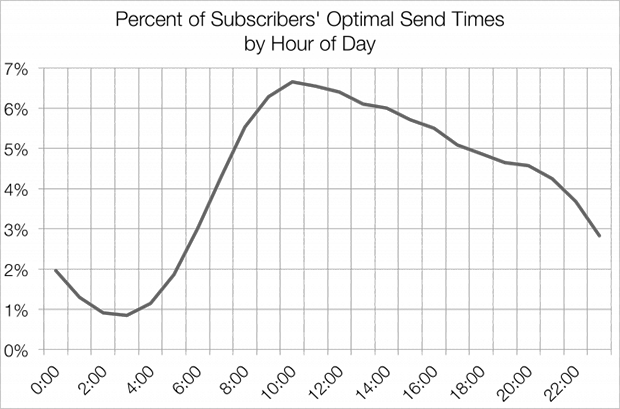
As for the best day to send emails, they saw the best results on Thursdays:

Of course, results will vary depending on your industry and your prospects. In this study by HubSpot, Monday through Wednesday are best, with Tuesday earning 20% more opens.
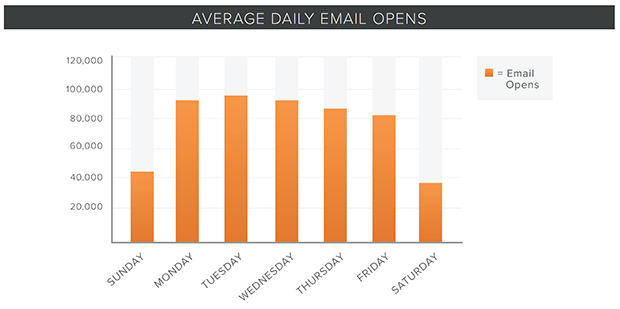
To know what works best for you, think about your prospect’s time zone when they’re likely to be in the office, and the time of day they’re most likely to check their emails.
TIPS TO RAISE REPLY RATES

Cold email is about 3 things:
- Taking the first step toward a long-term, mutually beneficial relationship
- Finding out if you’re a good fit
- Gauging interest
But for that to happen you have to entice people to reply. Here are some tips to help you do just that.
18. Use Laser Targeting
To get a reply, you need to send the right message to the right person at the right time. For that, you need to use laser targeting. And you need to be sure every detail of your message is a good match for your prospect. Personalization is your best bet here. But before you personalize, you need to build some context.
Build Context
The idea of examining your recipient’s’ digital presences before sending deserves further exploration here, because doing so has the potential to turn cold leads into warmer ones.
Imagine that you take any of the following steps with people you’re about to cold message:
- Following them on social
- Commenting on their blog posts
- Engaging with them on forums
- Sending them non-sales emails (for example, sending your congratulations on a recent guest post)
- Attending in-person networking events with them
- Joining Slack groups in your industry where they’re active
Personalize
FastCompany sent 1000 emails to high-level execs — busy professionals who rarely have time to open emails, much less cold emails.
In that campaign, 707 emails delivered successfully, with a 45.5% open rate. That’s impressive for any campaign, but especially so when you consider their list.
How did they raise their email open rate so high? Three things:
- They personalized every email.
- They researched their contacts ahead of time to be sure their personalization was a fit.
- They used a highly targeted list that precisely fit their buyer persona.
Statistics and Case Studies
According to some estimates, “Personalized emails deliver six times higher transaction rates” than standard messages (though the same survey acknowledges that 70% of brands fail to use them). This isn’t just a smart business practice – it’s a strategic advantage as well, compared to brands that aren’t yet using this strategy.
Personalizing your messages involves making sure that the content you send in your cold emails is tailored as closely as possible to your prospects’ needs. For instance, you wouldn’t want to send a message promoting a product someone has already purchased, and you wouldn’t want to build your email around pain points the recipient isn’t actually experiencing.
To get inspired about all that’s possible under the umbrella of personalization, check out the following case studies:
- How 5 Retailers Use Personalized Emails For Unbelievable Results
- 12 Personalized Email Examples You Can’t Help but Click
- 45 Examples of Personalized Marketing That Really Work
Once you have a better idea of the types of personalization you’d like to incorporate into your cold emails, look into the features offered by the tools you’re using. If you have a marketing automation program installed, you may have access to a number of personalization options already – from form field replacements to CTA replacements.
Personalization isn’t an easy-button. But it is the lever that drives better results. If you only use one tip from this list, this is the one you need to double down on.
19. Keep It Short
The Golden Rule in cold emails is not to waste people’s time. So your message needs to be short and to the point.
Say enough to be clear and compelling, but no more.
This example is a bit long for a cold email. I look at the long wall of text, and I want to exit right away:
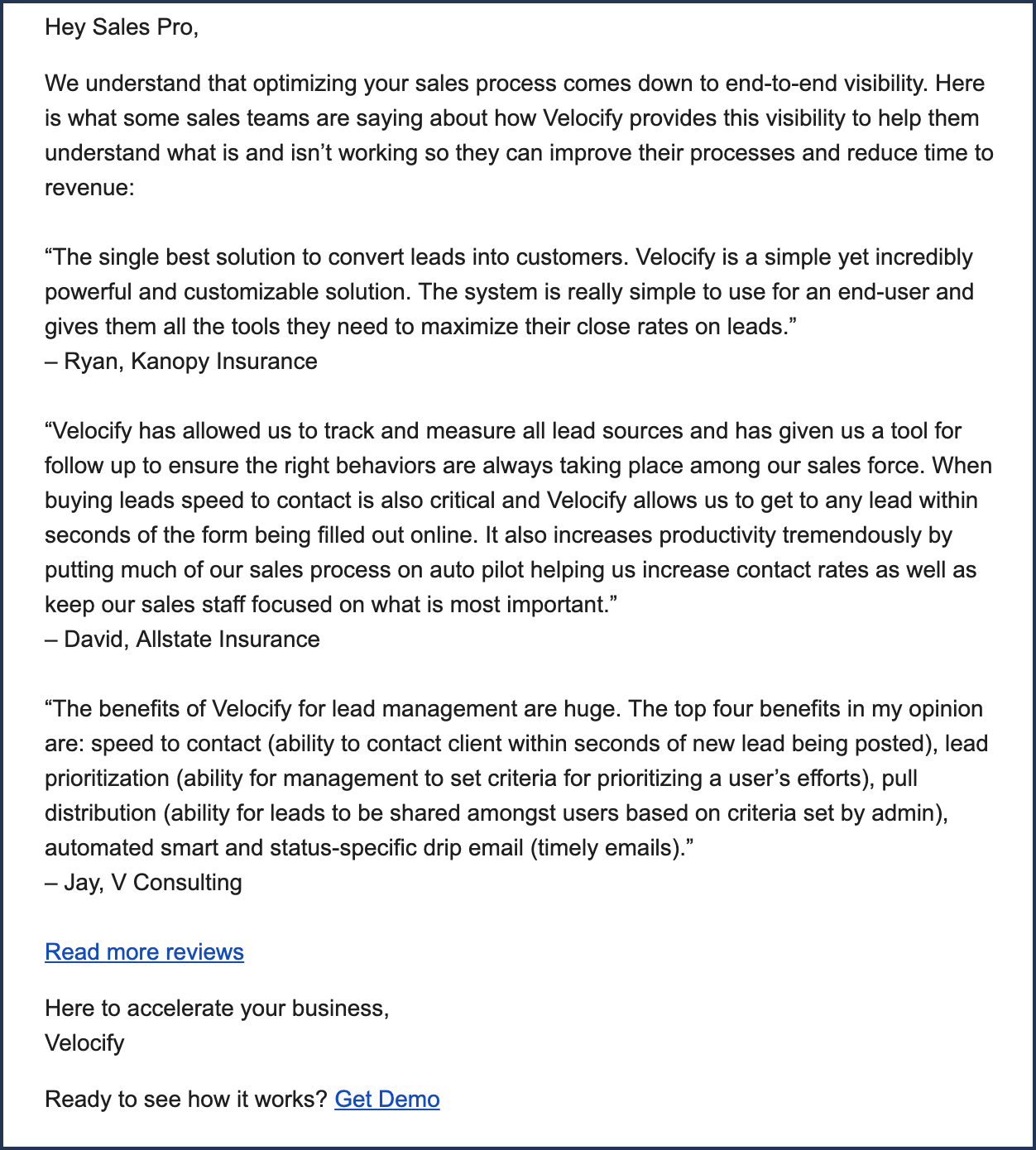
Interestingly, as long as this is, it gives me very little information. It’s also focused solely on the sender. To be more successful, it needs to address the prospect’s needs and talk more about benefits.
Here’s another example:

This email is just two lines long and has all the vital information it needs. If the prospect had a burning need, they might actually respond. But it falls short in persuading anyone who isn’t actively looking for a shredder.
Even short emails need to:
- Provide context.
- Tell your prospect why they should reply.
- Talk about your prospect more than your product: What’s in it for them?
Keep the following three rules in mind as you work to cut the crap from your cold emails:
- Be original. Avoid overused expressions or formulaic templates. If you decide to work off of existing templates to speed up your cold emailing process, customize them so that they match your tone and objectives (and so that you don’t get called out by a prospect who’s received the same message from another sales rep).
- Be generous. Your cold email isn’t the place to talk about how much a sale would mean to you. Self-centered messaging repels readers. Keep the benefits focused on them instead by clearly stating the problem you’re solving and how your solution impacts them personally.
- Be clear. Rambling off a message full of jargon or highly-technical terms doesn’t make you sound smart – and it won’t make your readers want to take action. Keep your message short, sweet, simple and easily-understood. Readers will delete messages they don’t understand.
Not sure if you’re hitting these marks? Do a gut check. Would you be happy receiving the message you’re about to send someone?
20. Make Multiple Touches
The real reason most of your cold email recipients don’t respond? They’re busy.
How do you keep it short and still get results? How do you give enough information to get people’s interest and drive action?
You send multiple emails over time.
It often takes 7 to 10 touches before you get a positive response from a cold prospect. Why, then, do we expect to get a response from one email?
As long as you’re not sending the same message over and over again (and you offer a way to opt-out of the campaign), you can send 3, 5, or more emails in one campaign.
In a Woodpecker study, for instance, campaigns with 4–7 emails per sequence received 3X more responses than campaigns with only 1–3 emails in a sequence.
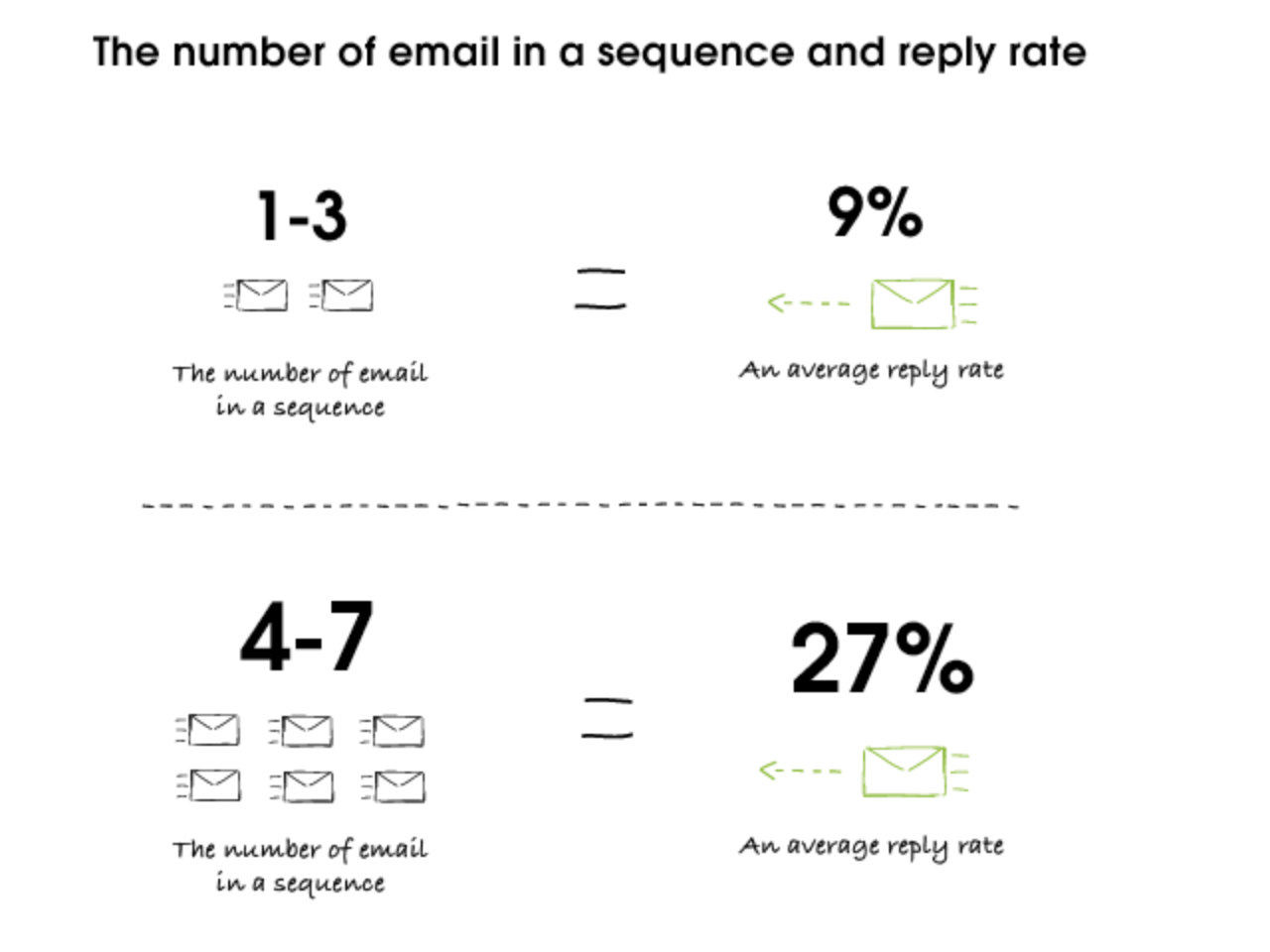
So map out your campaign, assigning a unique purpose to each email in your campaign. For instance:
- Email 1: Offer
- Email 2: Urgency on the offer
- Email 3: Different, but related, offer
- Email 4: Ask if they have any questions
- Email 5: Share success story and ask if they’d like a demo
With this approach, there’s no need to pack too much into any one email. Each email in the sequence has a specific purpose, so it can stay focused and short.
The key is to follow up.
When building a follow-up sequence, consider the following from Tenfold:
“According to a study by Marketing Donut, 80 percent of sales take 5 follow-up phone calls after the initial meeting to close. However, it was found in this study that almost half of salespeople give up after just one follow-up. Having a persistent follow-up plan in place already puts you ahead of the curve.”
That’s why it’s so critical that you don’t give up after your first message. According to Yesware, you have a 21% chance of getting a reply to your second email if the first goes unanswered. That’s a huge number of potential leads or sales you could be missing out on by failing to follow up.
RELATED: Cold Email vs SPAM – What’s The Difference?
21. Be Direct
If you beat around the bush and fail to share anything of value, you’re wasting your prospect’s time (and yours, if you’re honest).
So get to the point. Say what you need to say. No fluff. No hedging.
22. Don’t Be Pushy or Demanding
There’s no need to be pushy or demanding. So focus on being friendly.
Be aware, you can come off as pushy while still being technically polite. Phrases like, “All I require is” can signal that you’re expecting a transactional exchange — tit for tat.
Don’t do that. Give freely. Reciprocity happens naturally. You don’t have to demand it.
23. Don’t Forecast a Sales Pitch Down the Road
As I mentioned earlier, no one likes to be sold. If your “give” comes off as a set-up for a sales pitch in the next email, no one will respond.
Again, be generous. Give freely. Don’t signal that you ultimately want something in return.
RELATED: What Happened to Relationship Selling?
24. Have a Credible Email Signature
This is about trust. People are most likely to engage with a reputable brand. So make sure every element of your email looks credible.
Here’s an email signature that oozes professionalism:
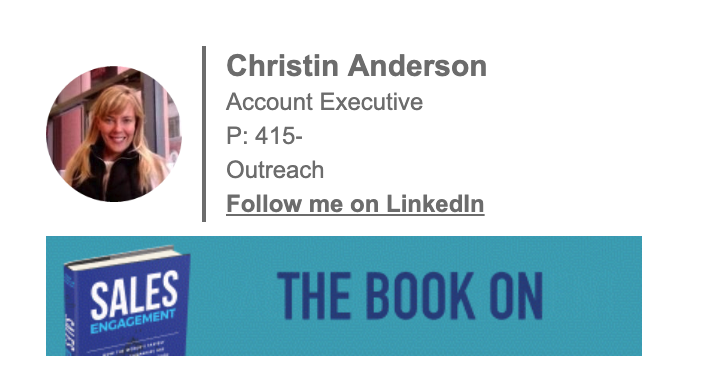
You can create something similar, even without the fancy design elements:
- Create a profile, so people can put a face to your name.
- Include your title and the company you work for.
- Include social media links.
- Include a phone number where people can reach you.
All of these things build social proof and make you look credible.
25. Send From a Branded Email Address
Along the same lines, your “Send” email can make or break your response rates. Ideally, you should use a branded email. Something like:
your.name@yourcompany.com
fname@yourcompany.com
Don’t send from your personal Gmail or Hotmail account. That’s unprofessional:
fname@genericemailserver.com
And by all means, don’t send from a spammy account that looks like this:
gy348z@gibberish-sypzzxyj.ru
Don’t have much branding yet? No problem.
Let’s work on growing a personal brand!
Imagine you receive a cold email, and you notice that the sender is someone you’ve seen writing for publications in your industry, interacting in forums or maintaining an active social presence. Are you going to be more likely or less likely to open that message than one from a sender you aren’t familiar with?
Of course, it’s the former. When you take the time to build a personal brand, you’re no longer an unknown quantity – or even a cold email at all. Instead, you’ll see more opens and better cold email performance, all because of the name you’ve built for yourself.
People build personal brands in all different kinds of ways, but a few to try might include:
- Publishing thought leadership articles to your blog
- Contributing guest articles to other industry sites
- Developing content for LinkedIn Pulse
- Producing SlideShare presentations
- Speaking at conferences
- Hosting webinars
Essentially, anything that puts your knowledge on display for your target audience has the potential to build your brand – and to increase your cold email success at the same time.
Cold Email Success: It’s Common Sense, Really
The cold email tips I’ve shared here are not rocket science. Success boils down to just a few common-sense rules:
- Treat people with respect.
- Be yourself.
- Give before you ask.
- Build trust before you try to sell.
Follow these 4 rules, and you’ll likely nail your cold emails — tips or no tips.



